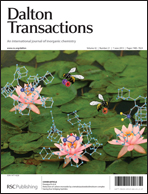Abstract
The reactivity of (LCN)2Sn (1) (where LCN is 2-(N,N-dimethylaminomethyl)phenyl-) towards various substrates containing E–Cl bond(s) has been studied (E = C, Si, Ge and Sn). Alkyl chlorides like chloroform or dichloromethane reacts with 1 to form (LCN)2SnCl2 and unidentified by-products in poor yields. The reaction of benzoyl chloride with 1 at low temperature yielded a thermally unstable product (LCN)2Sn(Cl)C(![[double bond, length as m-dash]](https://www.rsc.org/images/entities/char_e001.gif) O)Ph (2) which was isolated and characterized by both multinuclear NMR spectroscopy and X-ray diffraction techniques. The vicinity of the central tin atom in 2 reveals trigonal bipyramidal geometry. Attempts to oxidize 2 by dioxygen to give the corresponding organotin(IV) benzoate failed. On the other hand, the reaction of the in situ prepared (LCN)2Sn
O)Ph (2) which was isolated and characterized by both multinuclear NMR spectroscopy and X-ray diffraction techniques. The vicinity of the central tin atom in 2 reveals trigonal bipyramidal geometry. Attempts to oxidize 2 by dioxygen to give the corresponding organotin(IV) benzoate failed. On the other hand, the reaction of the in situ prepared (LCN)2Sn![[double bond, length as m-dash]](https://www.rsc.org/images/entities/char_e001.gif) O (synthesized by the reaction of 1 with dioxygen) with PhCOCl resulted in the formation of the desired organotin(IV) benzoate (LCN)2Sn(Cl)C(
O (synthesized by the reaction of 1 with dioxygen) with PhCOCl resulted in the formation of the desired organotin(IV) benzoate (LCN)2Sn(Cl)C(![[double bond, length as m-dash]](https://www.rsc.org/images/entities/char_e001.gif) O)OPh (3). The reaction of 1 with Ph3GeCl yielded triphenylgermyl-substituted diorganotin(IV) chloride (LCN)2Sn(Cl)GePh3 (4) which subsequently gave mixed diorganotin(IV) chloride-oxide [(LCN)2SnCl]2O (5) upon loss of the GePh3 moiety in the air. When the same reaction was carried out in benzene instead of chloroform a unique [Ph3Ge]4[Sn6O8] cluster (6) was obtained. Similarly, the reaction of 1 with Ph3SiCl provided triphenylsilyl-substituted diorganotin(IV) chloride (LCN)2Sn(Cl)SiPh3 (7) which was then oxidized to (LCN)2Sn(Cl)OSiPh3 (8). The unprecedented reaction of 1 with (n-Bu)3SnCl provided the distannane (LCN)2Sn(Cl)SnBu3 (9) which could be oxidized by dioxygen to a distannoxane (LCN)2Sn(Cl)OSnBu3 (10). In addition, the solid-state structures of 3, 5, 6 and 8 were determined by the X-ray diffraction techniques.
O)OPh (3). The reaction of 1 with Ph3GeCl yielded triphenylgermyl-substituted diorganotin(IV) chloride (LCN)2Sn(Cl)GePh3 (4) which subsequently gave mixed diorganotin(IV) chloride-oxide [(LCN)2SnCl]2O (5) upon loss of the GePh3 moiety in the air. When the same reaction was carried out in benzene instead of chloroform a unique [Ph3Ge]4[Sn6O8] cluster (6) was obtained. Similarly, the reaction of 1 with Ph3SiCl provided triphenylsilyl-substituted diorganotin(IV) chloride (LCN)2Sn(Cl)SiPh3 (7) which was then oxidized to (LCN)2Sn(Cl)OSiPh3 (8). The unprecedented reaction of 1 with (n-Bu)3SnCl provided the distannane (LCN)2Sn(Cl)SnBu3 (9) which could be oxidized by dioxygen to a distannoxane (LCN)2Sn(Cl)OSnBu3 (10). In addition, the solid-state structures of 3, 5, 6 and 8 were determined by the X-ray diffraction techniques.


 Please wait while we load your content...
Please wait while we load your content...